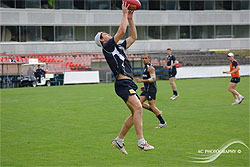AFL - A History

The Australian Football League is the country’s most popular sporting competition. The AFL gradually evolved after a century of mergers between several regional Aussie rules clubs.
Today, the Australian Football League is financially the strongest sporting league in the country, with substantial media and corporate sponsorship programs under its belt.
The League has its origin in Australian Rules football that began in Melbourne in 1858. Several of the existing AFL teams were formed over a century and a half ago, such as the first club, Melbourne Football Club in 1859 and the Victorian Football Association which was started in 1877 with eight teams: Carlton, Collingwood, Essendon, Fitzroy, Geelong, Melbourne, South Melbourne, and St. Kilda. The game now came to be known as the "Melbourne Rules", "Victorian Rules" or "Australasian Rules" and soon began to spread from Victoria into other Australian colonies such as Tasmania, Queensland, South Australia, New South Wales, and Australian Capital Territory.
It was in 1879 that the first inter-colonial match was played between Victoria and SA. By the 1890s, the South Australian National Football League and the West Australian Football League were strong, separate competitions. Soon after, a rift in Victoria Football Association led to the formation of Victorian Football League, which started playing separately in 1897. By the year 1925, the Victorian Football League became the most prominent league after it was joined by Richmond and University in 1908, although University withdrew in 1915 due to the war. Footscray, Hawthorn, and North Melbourne fell in line in 1925. The 12 team configuration underwent changes in 1982 with the relocation of South Melbourne to Sydney. The West Coast Eagles from Western Australia and the Brisbane Beers from Queensland Jumped onto the football bandwagon in 1987.
For most of the 20th century, the South Australian National Football League, the West Australian Football League and the Victorian Football League were considered as peers. They continued playing each other at various challenge matches and nationwide club competitions.
The modern day Australian Football League came into being in 1990 after Victorian Football League’s governing body decided to market the competition, as an official national league and thus renamed itself. Now recognized as the governing body of Australian Football by majority international leagues, the AFL Commission has gained control over the game, framing it’s’ laws in the process.
With the introduction of the Australian Football League all other state leagues including South Australian National Football League, and the West Australian Football League underwent rapid decline. In its new avatar, since renaming, the league has been successful in pushing other the affiliated leagues into co-branding themselves with it. The national event today has its teams based in five of at least six Australian states. It is enthusiastically watched by million of spectators in 22 game rounds between the months of March and early September. After a series of preliminary matches, the Australian Football League’s high octane grand final is played between the two finalists.
The Australian Football League hasn’t looked back and continues to expand itself. It was joined by Adelaide Football Club, Football Club in 1995, Brisbane Lions, and the Port Adelaide Football Club. By 2011, there were nine clubs from Melbourne, one from Victoria's second largest city, Geelong, two teams from South Australia, two from Western Australia and one each from Sydney, New South Wales and Brisbane and the Gold Coast, Queensland.
Australian football league is the most participated football code to have swept the nation and it continues to grow rapidly.